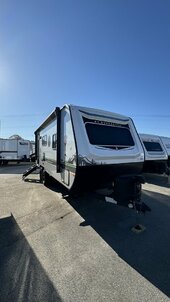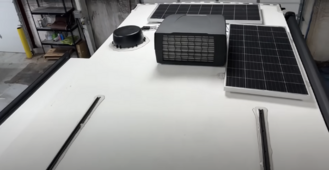Been out of the game and unmotivated for a while since I moved from sunny Colorado to the east coast. Fed up with life and how much I've stagnated being here so I just purchased this thing yesterday. Haven't picked up yet and specs aren't well documented on the camper mfg's website. Here's what I do know from either mfg or pausing youtube walkthrough videos:
2024 No Boundaries 19.6 25ft with Beast Suspension Package
(Tow vehicle: 2022 F250 King Ranch Tremor)
- 2 x 200w panels from factory
- Some doodoo 30 amp GoPower PWM charger (likely GP-SB-PWM-30BT)
- 2000w pure sine wave inverter (WFCO WF5220)
- WFCO Lead/Lithium Auto-detect converter/charger (read bad things from people a few years ago about lithium mode not charging to full, maybe fixed by now)
- Roof tracks and cross bars to install other stuff, more panels in my case

And the roof layout I can expect:

With that out of the way...
These are assuredly GoPower 12v panels wired in parallel. Could be one of two 200w panel flavors they have:
20.8V Amp / 9.62A Imp / 24.3A Voc / 10.09A Isc OR
19.11V Amp / 9.65A Imp / 22.78 Voc / 9.32A Isc
Battery:
There are a few 200ah LFP batteries on the market that fit on the tongue if I install a dual group 24 battery box. That's about all I can do up there with curve of the camper and frame rails. I'm OK with that. Alternatively, I could fuss with bringing batteries inside and beneath the bed or in to the storage passthru and go with more capacity. Kind of sounds like a pain in the peen. In any event, I would like to stay 12v and understand the tradeoffs.
Charge controller: I don't want that GoPower thing at all even know it can handle lithium. I am too married to Victron and have several 12v charge controllers just collecting dust. 75/15 SmartSolar x 2, 100|30, 150|45. Perplexingly, the existing roof gland is at the front of the camper. The existing charge controller is at the bathroom in the rear of camper. The batteries are up front. Make it make sense lol. It's probably all 8 gauge wire.
Someone did post a video on YT that gave me an idea though. He disconnected the battery from the charge controller (front of trailer there's some wires you can expose in the underbelly) and then joined the solar input wires and old battery wires. That's his new solar input wire, but i'd really want to bump up my voltage to keep that same 8 gauge wire while pushing more power.
Solar upgrades:
I want to max out the space I'll be afforded by the existing tracks and cross rails so I'll play around with panel selections later, but I cannot wrap my head around what to do to avoid drilling the roof for another entry gland.
With the air conditioning position I believe I'm kind of screwed on doing anything to change the front two panels from parallel. I have so much Victron gear from my glory days that I'd like to reuse, but it's of little use if I just add more panels in parallel. Not to mention the current I'd be pushing through the wires. SOOO what would you do?
Charger/converter: whether WFCO fixed the dog crap charging profile for lithium they evidently had years ago or not, I'll rarely be plugged in to grid power. I'll consider that a wash unless I can remove it from the equation all together with a multiplus or something.
Existing 2000w inverter: This inverter has an AC passthru and only powers the outlets. It does not deal with the 15kbtu AC. I assume there's some wires that are currently separated behind the fuse panel to do this, since plugging in to grid will do the inverter passthru and bring the AC to life. Maybe in the future I could join those wires if I 1) replaced the inverter with the largest 12v Multiplus or whatever new may be on the market, and 2) Had batteries that could handle the current. Thoughts to mull over?
Tow vehicle:
I'd just be running the camper's 12v compressor fridge while driving, any battery charge would be a plus. I already have a Victron 12/12-18 Orion TR-Smart Isolated just collecting dust. It's unclear as to whether the truck will output enough current to pull this off through the 7-pin. Happy to do anderson plugs on rear bumper though.
Another TL;DR post from me, so not everything changes. If anyone even skims it and has a lightbulb moment, I'm all ears. I'm really just wrapped up in how I'm going to add more solar, not have to drill the roof again, and not waste the existing 400w of solar panels up there. That's the puzzle I'm most eager to solve!
Thanks!
2024 No Boundaries 19.6 25ft with Beast Suspension Package
(Tow vehicle: 2022 F250 King Ranch Tremor)
- 2 x 200w panels from factory
- Some doodoo 30 amp GoPower PWM charger (likely GP-SB-PWM-30BT)
- 2000w pure sine wave inverter (WFCO WF5220)
- WFCO Lead/Lithium Auto-detect converter/charger (read bad things from people a few years ago about lithium mode not charging to full, maybe fixed by now)
- Roof tracks and cross bars to install other stuff, more panels in my case

And the roof layout I can expect:

With that out of the way...
These are assuredly GoPower 12v panels wired in parallel. Could be one of two 200w panel flavors they have:
20.8V Amp / 9.62A Imp / 24.3A Voc / 10.09A Isc OR
19.11V Amp / 9.65A Imp / 22.78 Voc / 9.32A Isc
Battery:
There are a few 200ah LFP batteries on the market that fit on the tongue if I install a dual group 24 battery box. That's about all I can do up there with curve of the camper and frame rails. I'm OK with that. Alternatively, I could fuss with bringing batteries inside and beneath the bed or in to the storage passthru and go with more capacity. Kind of sounds like a pain in the peen. In any event, I would like to stay 12v and understand the tradeoffs.
Charge controller: I don't want that GoPower thing at all even know it can handle lithium. I am too married to Victron and have several 12v charge controllers just collecting dust. 75/15 SmartSolar x 2, 100|30, 150|45. Perplexingly, the existing roof gland is at the front of the camper. The existing charge controller is at the bathroom in the rear of camper. The batteries are up front. Make it make sense lol. It's probably all 8 gauge wire.
Someone did post a video on YT that gave me an idea though. He disconnected the battery from the charge controller (front of trailer there's some wires you can expose in the underbelly) and then joined the solar input wires and old battery wires. That's his new solar input wire, but i'd really want to bump up my voltage to keep that same 8 gauge wire while pushing more power.
Solar upgrades:
I want to max out the space I'll be afforded by the existing tracks and cross rails so I'll play around with panel selections later, but I cannot wrap my head around what to do to avoid drilling the roof for another entry gland.
With the air conditioning position I believe I'm kind of screwed on doing anything to change the front two panels from parallel. I have so much Victron gear from my glory days that I'd like to reuse, but it's of little use if I just add more panels in parallel. Not to mention the current I'd be pushing through the wires. SOOO what would you do?
Charger/converter: whether WFCO fixed the dog crap charging profile for lithium they evidently had years ago or not, I'll rarely be plugged in to grid power. I'll consider that a wash unless I can remove it from the equation all together with a multiplus or something.
Existing 2000w inverter: This inverter has an AC passthru and only powers the outlets. It does not deal with the 15kbtu AC. I assume there's some wires that are currently separated behind the fuse panel to do this, since plugging in to grid will do the inverter passthru and bring the AC to life. Maybe in the future I could join those wires if I 1) replaced the inverter with the largest 12v Multiplus or whatever new may be on the market, and 2) Had batteries that could handle the current. Thoughts to mull over?
Tow vehicle:
I'd just be running the camper's 12v compressor fridge while driving, any battery charge would be a plus. I already have a Victron 12/12-18 Orion TR-Smart Isolated just collecting dust. It's unclear as to whether the truck will output enough current to pull this off through the 7-pin. Happy to do anderson plugs on rear bumper though.
Another TL;DR post from me, so not everything changes. If anyone even skims it and has a lightbulb moment, I'm all ears. I'm really just wrapped up in how I'm going to add more solar, not have to drill the roof again, and not waste the existing 400w of solar panels up there. That's the puzzle I'm most eager to solve!
Thanks!


